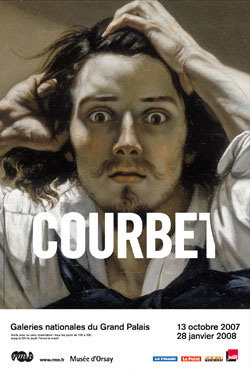Gustave Courbet
dal 12/10/2007 al 27/1/2008
Segnalato da
Gustave Courbet
Laurence des Cars
Dominique de Font-Reeaulx
Gary Tinterow
Michel Hilaire
12/10/2007
Gustave Courbet
Galeries nationales du Grand Palais, Paris
The exhibition - divided into eight sections - presents 120 paintings, about 30 graphic works and some 60 photographs. This retrospective brings out the complexity of Courbet's work and its sometimes paradoxical links with the representation of reality and the pictorial tradition. It reassesses his place in his time and analyses his links with other art forms, particularly photography.

Retrospective
Curators
Laurence des Cars, Curator at the Musée d’Orsay,
Dominique de Font-Réaulx, Curator at the Musée d’Orsay,
Gary Tinterow, Engelhard Curator in charge of the Department of Nineteenth-century, Modern and Contemporary Art at the Metropolitan Museum of Art
Michel Hilaire, Director of the Musée Fabre, Montpellier.
An exhibition organised by the Rmn and the Musée d’Orsay with the Metropolitan Museum of Art, New York, and the Communauté d’agglomération de Montpellier / Musée Fabre.
Supported by the Bettercourt Schueller Foundation
It will be shown at the Metropolitan Museum of Art from 27 February to 18 May 2008 and at the Musée Fabre from 13 June to 28 September 2008.
This exhibition presents 120 paintings, about 30 graphic works and some 60 photographs in an area of 1500 square metres. Since 1977 (when the last major monograph exhibition on Courbet was held in Paris) extensive research in France and abroad has enabled us to re-evaluate Courbet's (1819-1857) oeuvre in the context of the art of 1840-1860. The exhibition will be an opportunity for a new generation to discover the work of a painter who was a major figure in the history of nineteenth-century art in all its breadth and diversity.
This retrospective brings out the complexity of Courbet’s work and its sometimes paradoxical links with the representation of reality and the pictorial tradition. It reassesses his place in his time and analyses his links with other art forms, particularly photography. The exhibition therefore gives the keys to understanding a many-facetted oeuvre, the manifesto of realism in 1848-1855 and its consequences for art history. This approach provokes thought about the nature of Courbet's realism and the role of Romanticism in his work. It sheds light on an influence which was decisive for the adepts of “New Painting” in the 1860s and the beginnings of Impressionism.
The exhibition is divided into eight sections:
1. Inventing Courbet: Youthful Self Portraits
For the first time, this section brings together an important set of self portraits painted or drawn between 1840 and 1855. In a romantic vein, the artists put himself at the centre of his work giving his self portraits an importance that reminds us of Rembrandt.
2. From Private Life to History. Throughout his life Courbet remained true to his family origins and his native land. They inspired his first great canvases which asserted his talent as an artist.
3. The Manifestoes. This section focuses on the Burial at Ornans and The Artist's Studio, exceptionally transferred from the Musee d'Orsay to the Grand Palais; it brings out the coherence of Courbet's artistic ambitions in the early 1850s and the mise en scène of those ambitions by the painter himself.
4. Landscapes. The landscape section is arranged around two fine series on the grottoes along the Loue River and the waves on the Normandy coast, including the most important versions. This theme offers a pertinent examination of parallels with contemporary photography – especially the work of Le Gray, Le Secq and Giroux.
5. The Modern Temptation. During the 1860s, Courbet, then at the peak of his fame, was a key reference for the rising generation of New Painting and early Impressionism; the work of these young painters stimulated Courbet in return, particularly in his portraits and modern subjects.
6. The Nude: Flouting Tradition. The female nude was a major stake for Courbet who painted his first nudes in the 1840s. His presentation of Bathers in 1853 (Musée Fabre, Montpellier) gave him a chance to assert his faithfulness to tradition and his desire for a realist renewal. Around The Origin of the World (1866, Musée d'Orsay, Paris), this section brings together all his major canvases in this genre from Sleeping Bacchante (1844-45, UNICEF foundation, Cologne) to Woman with a Parrot (1866, The Metropolitan Museum of Art).
7. The Artist as a Melancholic Hunter. Courbet’s works on a hunting theme have often been overlooked by art historians. And yet they are an important part of history painting, highlighted in the exhibition by a display of large pictures – The Death of the Stag (1866, Musée des Beaux-Arts, Besançon), Stags Fighting (1861, Musée Départemental Gustave Courbet, Ornans) – surrounded by all the key works on this theme.
8. Personal Experience of History: Courbet and the Commune. Courbet’s relations with politics were complex. He took action for the first time during the siege of Paris and the Commune, when he was the president of the Artists’ Federation. He paid dearly for his political commitment, particularly for his part in pulling down the Vendôme column. Thrown into prison, in poor health and forced into exile in Switzerland from 1873, Courbet as an artist was thereafter a survivor. Except for his self-portrait at Sainte Pélagie (1861, Musée Départemental Gustave Courbet, Ornans), he did not deal directly with events he had witnessed or taken part in. The gloomy series of still lifes painted between 1871 and 1873 was an outlet for his distress.
The exhibition closes with an unusual presentation of the three paintings of Trout from the Loue River, which are metaphors for the artist and his desperate fate.
An invitation has been extended to Swiss photographer Balthasar Burkhard to take several photographs of great dimensions in reference to Gustave Coubert’s work, which will be presented inside the exhibition at the monumental stairway of the Grand Palais.
Galeries nationales du Grand Palais
Place Clemenceau - Paris
Hours: 10 am to 10 pm.; Thursdays: 10 am to 8 pm.



